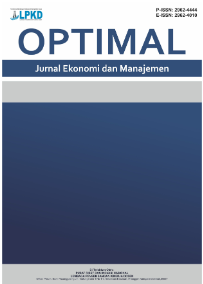Analisis Kendala-Kendala Kegiatan Pekerjaan Pengerukan Terhadap Keselamatan Pelayaran di Kolam Pelabuhan Tanjung Perak Surabaya
DOI:
https://doi.org/10.55606/optimal.v5i1.5779Keywords:
Siltation, Dredging, SafetyAbstract
Shallowing due to sedimentation in the Tanjung Perak Port Pool, Surabaya is one of the main challenges that affect shipping safety. This shallowing can reduce the depth of the pool, hinder ship maneuvering, and increase the risk of ships running aground, especially for large ships. Periodic dredging is a strategic solution to maintain the depth of the port pool according to shipping safety standards, in accordance with the International Safety of Life at Sea (SOLAS) regulations. This study aims to determine, analyze and find efforts from the obstacles faced in the implementation of dredging activities in the Tanjung Perak Port Pool, Surabaya towards shipping safety. The research method used by the author includes descriptive analysis with a quantitative approach, data obtained by the author from questionnaires, interviews and field observations. The results of the study indicate that the main obstacles in dredging in the Tanjung Perak Port Pool, Surabaya include high ship traffic that hinders the smooth running of work, delays in the arrival of the Trailing Suction Hopper Dredger (TSHD) type dredger, and technical problems with dredging equipment. These obstacles have an impact on the dredging work process and increase the risk of shipping safety. There is a significant relationship between the constraints of dredging activities and shipping safety in the Tanjung Perak Port Basin, Surabaya, as evidenced by questionnaire data. Therefore, a strategy is needed to reduce the impact, such as improving coordination between the Port Authority and the Vessel Traffic Service (VTS), optimizing the dredging schedule, and improving maintenance of dredging equipment. With the improvement efforts in the dredging system, it is hoped that shipping safety in the Tanjung Perak Port Basin, Surabaya can be maintained, so that dredging work continues to operate optimally and supports the smoothness of maritime traffic in the Tanjung Perak Port Basin, Surabaya.
References
Amrullah, R. (2020). Pelabuhan dan serba serbinya (bisnis, jasa & fasilitas). https://scholar.google.com/citations?view_op=view_citation&hl=id&user=vsI-FwsAAAAJ&citation_for_view=vsI-FwsAAAAJ:Y0pCki6q_DkC
Andinuari, F., & Kurniawati, H. A. (2018). Desain konsep self-propelled backhoe dredger untuk operasi wilayah Sungai Kalimas Surabaya. Jurnal Teknik ITS, 7(1). https://doi.org/10.12962/j23373539.v7i1.29418
Ansyari, A. (2021). Analisis pengerukan (dredging) di kolam pelabuhan peruntukan kapal kontainer post panamax (Studi kasus di Pelabuhan Makassar New Port) (Skripsi, Universitas Hasanuddin). http://repository.unhas.ac.id/id/eprint/8882/
Ari Wulandari, D. (2007). Penanganan sedimentasi Waduk Mrica. Berkala Ilmiah Teknik Keairan, 13(4), 264–271.
Fauziansyah, R. (2018). Analisis pengerukan kolam labuh Tanjung Priok (Tugas akhir, Departemen Teknik Kelautan ITS, Surabaya).
Fogel, R. (n.d.). Facts about dredging plant and equipment. IADC, 4, 3–6.
Hardani, A. H. N., Andriani, H., Fardani, A. R., Ustiawati, J., Utami, F. E., Sukmana, J. D., & Istiqomah, R. R. (2020). Buku metode penelitian kualitatif. Revista Brasileira de Linguística Aplicada, 5(1).
Hatmawan, R. D. (2020). Metode riset penelitian kuantitatif.
Herijono, B., & Prayitno, M. M. E. (2017). Perancangan dredger ship untuk normalisasi hilir Sungai Kalimas. Seminar Master PPNS, 2(1), 215–220.
Hermiyanty, W. A. B., & D. S. (2017). Faktor yang mempengaruhi kinerja. Journal of Chemical Information and Modeling, 8(9), 1–58.
Kementerian Pendidikan, Kebudayaan, Riset, dan Teknologi Republik Indonesia. (2016). Kamus Besar Bahasa Indonesia. https://kbbi.kemdikbud.go.id/DataDasarMakna/Details?eid=3477&mid=4159&number=2
Kementerian Pendidikan, Kebudayaan, Riset, dan Teknologi Republik Indonesia. (2016). Hipotesis. https://kbbi.kemdikbud.go.id/DataDasarMakna/Explore?eid=29832&mid=35517&number=1
Menteri Perhubungan RI. (2011). Peraturan Menteri Perhubungan RI No. PM 68 Tahun 2011 tentang alur pelayaran di laut. http://hukum.unsrat.ac.id/men/menhub2011_68.pdf
Menteri Perhubungan RI. (2016). Alur pelayaran di laut dan bangunan dan/atau instalasi di perairan.
Mursidi, M. (2023). Analisis faktor yang mempengaruhi keselamatan pelayaran (Studi pada KSOP Tanjung Emas Semarang). Jurnal Aplikasi Pelayaran dan Kepelabuhanan, 14(1), 94–106. https://doi.org/10.30649/japk.v14i1.106
Salim, P., & Yuwono, S. (2002). Kamus bahasa Indonesia kontemporer (Edisi ke-3).
Priadana, R., & Sunarsi, D. (2021). Metode penelitian kuantitatif. https://books.google.co.id/books?hl=id&lr=&id=9dZWEAAAQBAJ
Raga, P. (2020). Dampak pengerukan dan reklamasi dalam pembangunan pengoperasian pelabuhan di Indonesia. Jurnal Penelitian Transportasi Laut, 17(4), 188–198. https://doi.org/10.25104/transla.v17i4.1405
Republik Indonesia. (2021). Peraturan Menteri Perhubungan Nomor PM 125 Tahun 2018 tentang pengerukan dan reklamasi.
Salsabil, S., Al-Abror, M. I., & Maulida, K. (2019). Review buku metode penelitian. Metode Penelitian Kuantitatif, 1, 8. https://www.academia.edu/41357369/Review_Buku_Metode_Penelitian_Kuantitatif_Dominikus_Dolet_Unaradjan_2019
Sembiring, A. E., Mananoma, T., Halim, F., & Wuisan, E. M. (2014). Analisis sedimentasi di muara Sungai Panasen. Jurnal Sipil Statik, 2(3), 148–154.
Sugiyono. (2015). Metodologi penelitian.
Undang-Undang Republik Indonesia No. 17 Tahun 2008. (2008). Tentang pelayaran. http://repositorio.unan.edu.ni/2986/1/5624.pdf
Downloads
Published
How to Cite
Issue
Section
License
Copyright (c) 2025 OPTIMAL Jurnal Ekonomi dan Manajemen

This work is licensed under a Creative Commons Attribution-ShareAlike 4.0 International License.








